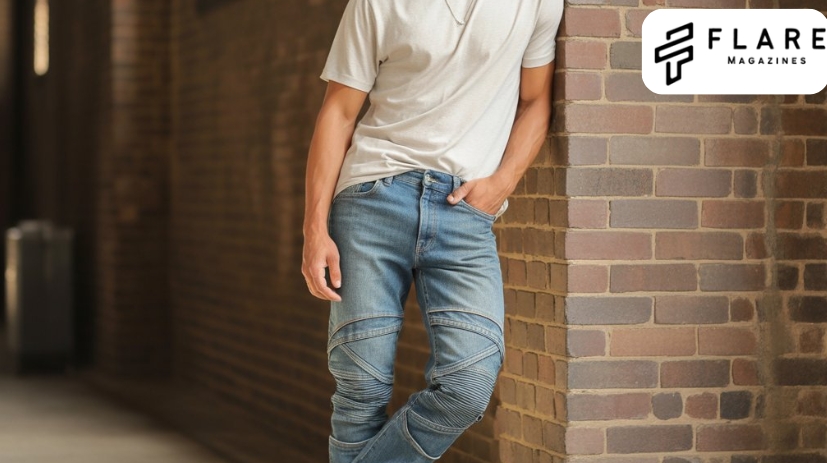Born from the demands of the open road, men’s biker jeans are a testament to purpose-driven design. Originally crafted to protect riders with reinforced panels and impact-resistant materials, today’s iterations retain that DNA while evolving into streetwear essentials. Features like moisture-wicking linings, breathable construction, and streamlined profiles ensure peak performance on and off the bike. For the modern man who values authenticity and adventure, biker jeans offer more than style—they’re armor for the asphalt and a badge of grit.
Roots of Rebellion – The Birth of Biker Jeans
- From Workwear to Road Warrior: The story begins not on the highway, but in the mines and fields. Standard denim jeans, pioneered by Levi Strauss, were valued for their rugged durability. Early motorcycle enthusiasts in the early 20th century, often working-class men se
- eking affordable thrills and transportation, naturally gravitated towards this sturdy fabric. However, standard jeans offered zero protection in the event of a spill.
- The Post-War Crucible & The Birth of the Outlaw Image: The end of World War II was pivotal. Returning veterans, accustomed to the adrenaline and camaraderie of military life, sought similar bonds and excitement. Motorcycle clubs formed, often comprised of these veterans. Hollywood seized this emerging image, most famously (and problematically) with Marlon Brando’s portrayal in The Wild One (1953). Brando’s character, Johnny Strabler, clad in a Perfecto leather jacket, white tee, and crucially, blue jeans, cemented the rebellious, outsider image. While not yet specialized biker jeans, these standard jeans became the uniform of the nascent “outlaw” biker culture. The need for something more protective was becoming glaringly apparent.
- Leather vs. Denim: The Early Divide: Leather was the obvious choice for abrasion resistance, leading to the iconic motorcycle jacket. However, full leather pants were often expensive, hot, and less practical for everyday wear than jeans. Riders needed a solution that offered better protection than regular denim but retained the comfort and casual style they craved. The quest for dedicated motorcycle jeans for men began in earnest.
- Early Reinforcements: The First Steps Towards Protection: Before specialized fabrics, riders took matters into their own hands. Common DIY modifications included:
- Leather Patches: Sewn onto high-impact zones like knees and seat.
- Double-Layering: Wearing two pairs of jeans or sewing extra layers of denim in critical areas.
- Canvas Overlays: Adding durable canvas panels. These crude solutions were the precursors to the engineered protection found in modern biker jeans men rely on.
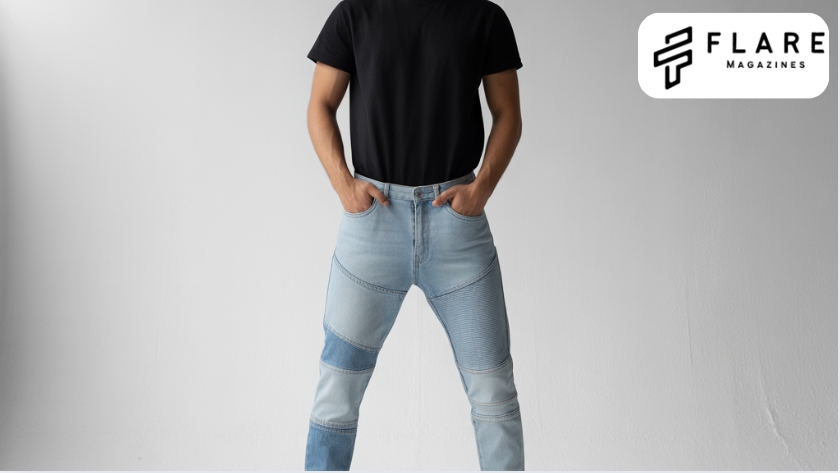
Anatomy of Protection – Deconstructing Modern Biker Jeans
Modern men’s biker jeans are feats of textile engineering, designed to shield the rider without sacrificing mobility or style. Understanding their components is key:
- The Foundation: Denim Choices
- Weight (Oz/yd²): Ranges from mid-weight (12-14oz) for comfort and style to heavy-duty (16oz+) for maximum durability and abrasion resistance. Heavier denim inherently provides better initial protection but can be stiffer. Biker jeans for men often use 13.5oz to 15oz as a sweet spot.
- Weave: Tight weaves (like broken twill or left-hand twill) offer better abrasion resistance than loose weaves. Selvedge denim, while prized for quality, doesn’t inherently offer better protection unless specifically engineered for riding.
- Stretch: The inclusion of elastane (Lycra, Spandex) (1-5%) is now almost standard in quality biker jeans men wear. It enhances comfort, freedom of movement on the bike, and overall fit. Non-stretch options exist but are less common.
- The Armor: Abrasion-Resistant Materials (The Game Changer): This is where motorcycle jeans for men truly diverge from regular denim.
- Aramid Fibers (Kevlar®/Cordura®): The gold standard. Woven into panels (usually seat, knees, hips, sometimes calves and thighs) or blended into the denim itself. Offers exceptional heat resistance and abrasion protection, significantly outperforming standard denim in slide tests. Kevlar® is often used as a lining, while Cordura® Denim blends aramid directly with cotton for a more integrated look and feel.
- Dyneema®: A high-performance polyethylene fiber, even stronger than Kevlar® weight-for-weight. Often used in premium biker jeans for men for its lightness and superior strength. Can be blended or used in panels.
- Covelite®/Other Proprietary Blends: Some brands use their own blends combining cotton with various synthetic fibers designed for abrasion resistance and sometimes additional features like water resistance or stretch.
- Full-Length vs. Panels: Full-length linings offer comprehensive protection but can be bulkier and hotter. Strategic panel placement (impact zones) balances protection with breathability and a more denim-like feel, a key feature sought in men’s biker jeans.
- The Shield: Impact Protection (CE Certified Armor): Abrasion resistance protects against road rash; impact protectors absorb the crushing force of impacts.
- CE Certification: The European standard (EN 17092) is the benchmark for motorcycle clothing safety. Biker jeans men purchase should ideally be CE certified, indicating they meet specific abrasion resistance, seam strength, and burst strength requirements. Levels include:
- AAA: Highest abrasion resistance (>7 seconds on the “Darmstadt” drum test), suitable for high-speed riding.
- AA: Good abrasion resistance (>5 seconds), suitable for most road riding.
- A: Basic abrasion resistance (>2.5 seconds), suitable for urban/low-speed riding.
- Pocket Placement: Quality motorcycle jeans for men feature integrated, secure pockets for removable CE-certified knee and hip armor (usually Level 1 or 2). Proper positioning is crucial – the armor must stay over the joint or bone in a crash. Some high-end jeans include integrated, non-removable protectors.
- CE Certification: The European standard (EN 17092) is the benchmark for motorcycle clothing safety. Biker jeans men purchase should ideally be CE certified, indicating they meet specific abrasion resistance, seam strength, and burst strength requirements. Levels include:
- Construction: Built to Last (and Protect):
- Reinforced Seams: Double or triple-stitching, often with heavy-duty thread (e.g., bonded nylon), especially in stress points like the crotch (gusseted designs are common), knees, and seat. Chain-stitching might be used decoratively but lock-stitching is stronger for critical seams.
- Reinforced Stress Points: Bar tacks at pocket corners, belt loops, and other high-stress areas prevent tearing.
- Yokes: Well-designed back yokes provide shape and reduce binding when seated on the bike – essential for biker jeans for men who ride for hours.
- Rise: A mid-to-high rise prevents “plumber’s crack” when leaning forward on the bike, a practical consideration for men’s biker jeans.
- Fit: Modern biker jeans offer various fits (Slim, Straight, Relaxed) but prioritize mobility. The leg cut allows for a bent-knee riding position without excessive bunching. Stretch fabric is key here.
- Hardware & Details:
- Zippers: Heavy-duty, often rust-resistant zippers on flies and pockets. Some feature locking pulls.
- Buttons/Rivets: Reinforced button flies or heavy-duty rivets.
- Pockets: Practical, often deep pockets. Wallet pockets might be lined with RFID-blocking material. Some designs feature dedicated pockets for armor or small tools.
- Reflective Elements: Subtle reflective piping or logos enhance nighttime visibility, a valuable safety addition to motorcycle jeans for men.
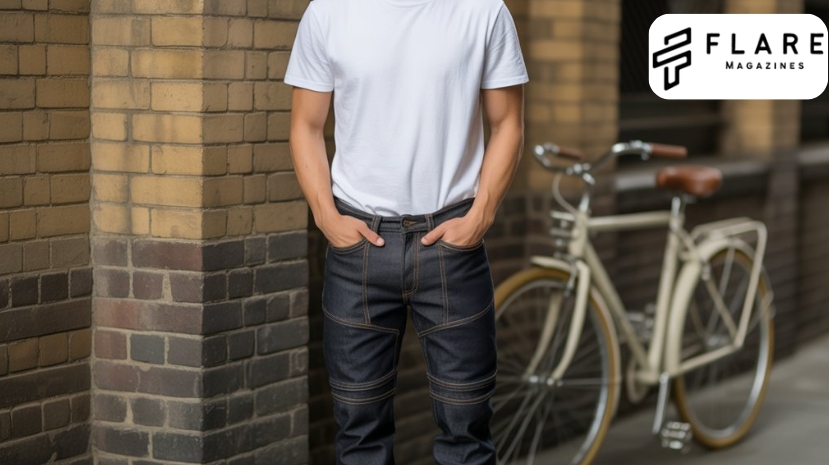
The Style Spectrum – From Classic to Contemporary
Men’s biker jeans have evolved far beyond basic blue. The market caters to diverse tastes, seamlessly blending protection with personal style:
- The Classic Blue Jean: Timeless indigo or dark wash denim. Looks like regular high-quality jeans but conceals protective technology. Perfect for riders who want subtlety. The quintessential “stealth” biker jean for men.
- Black Denim Dominance: Universally popular, black biker jeans men choose offer a sleek, modern look that pairs effortlessly with boots, sneakers, leather jackets, or casual tops. Hides minor scuffs better than blue. Often features subtle detailing like contrast stitching or pocket designs.
- Slim & Skinny Fits: Hug the leg without restricting movement (thanks to stretch). Offers a contemporary, streamlined silhouette popular with sportbike and modern cruiser riders. Provides a very close fit under motorcycle boots. A key segment of the men’s biker jeans market.
- Straight & Regular Fits: The traditional choice, offering room through the thigh and knee with a straight leg opening. Comfortable, classic, and works well with various boot styles. Represents the core heritage of biker jeans for men.
- Relaxed & Loose Fits: Provides maximum comfort and airflow, popular with touring riders and those favoring a more utilitarian or heritage look. Often features durable canvas blends or heavier denim.
- Design Details & Embellishments:
- Distressing: Light whiskering, fading, or minor abrasions for a worn-in look. Less common on heavily protected jeans due to the lining.
- Stitching: Contrast stitching (yellow, orange, white) is a classic biker detail. Subtle tonal stitching offers a cleaner look.
- Pocket Styles: Traditional five-pocket design, Western-style yoke pockets, or minimalist designs.
- Embroidery/Patches: Some brands incorporate subtle branding or thematic embroidery. Removable patches allow for personalization of men’s biker jeans.
- Tapered Legs: Combines room in the seat and thigh with a narrower leg opening, creating a modern silhouette that fits well over boots.
- Beyond Denim: Cordura® & Hybrids: Many premium biker jeans men select utilize Cordura® Denim blends (cotton + Cordura® nylon) for enhanced durability and abrasion resistance right in the face fabric. Others feature textile panels (often in black) integrated into the denim for a hybrid look and feel, maximizing protection zones.
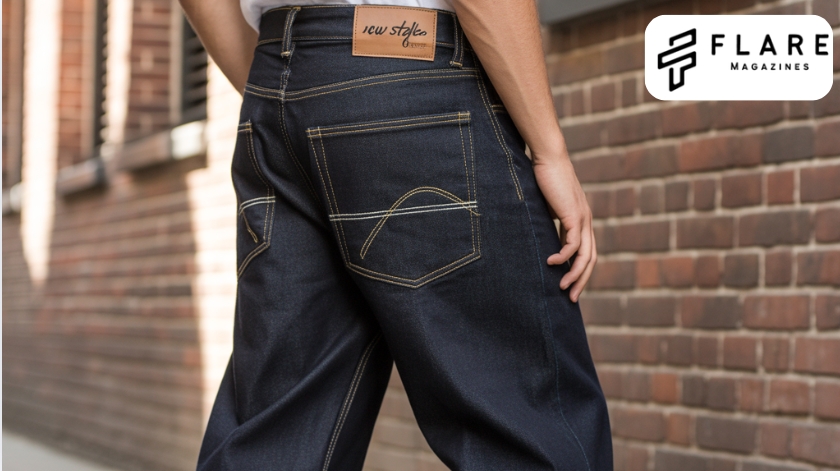
Purpose-Driven Choices – Matching Jeans to Ride & Rider
Not all biker jeans for men are created equal. Choosing the right pair depends heavily on riding style, bike type, climate, and personal priorities:
- The Commuter/Urban Rider:
- Priority: Style, comfort, everyday wearability, basic protection (CE Level A or AA).
- Jeans Choice: Slim or straight fit, lighter weight denim (12-14oz), stretch fabric, often Kevlar® panels for discreet protection. Look like regular jeans. Ideal motorcycle jeans for men navigating city streets.
- The Weekend Warrior/Cruiser Rider:
- Priority: Classic style, good protection (CE Level AA), comfort for moderate rides.
- Jeans Choice: Straight or relaxed fit, classic indigo or black denim (13.5-15oz), Kevlar® or Cordura® panels, often with more traditional detailing. Represents the classic image of biker jeans men.
- The Sport/Touring Rider:
- Priority: High protection (CE Level AA or AAA), excellent fit for riding position (pre-curved legs, stretch), impact protection (knee & hip armor), durability, potentially weather resistance.
- Jeans Choice: Slim or tapered fits often preferred for aerodynamics and fit under fairings. Heavier denim or Cordura® blends, full-length or extensive aramid protection, armor included or pockets for it. Premium biker jeans for men focused on safety.
- The Adventure Rider:
- Priority: Durability, abrasion resistance, comfort for long days, potentially water/wind resistance, versatility.
- Jeans Choice: Relaxed or straight fit for mobility, often Cordura® heavy blends or hybrid designs with textile panels, higher CE ratings (AA/AAA), may have cargo pockets, gusseted crotch. Rugged men’s biker jeans built for diverse terrain.
- Climate Considerations:
- Hot Weather: Lighter denim weight, mesh-lined panels for breathability, minimal lining, stretch for airflow. Look for biker jeans men designed for ventilation.
- Cool/Cold Weather: Heavier denim, windproof linings (removable or fixed), potential for thermal liners. Cordura® blends offer inherent wind resistance. Motorcycle jeans for men can be layered effectively.
- Wet Weather: While not waterproof, some biker jeans for men feature DWR (Durable Water Repellent) finishes. For serious rain, waterproof overpants are recommended.
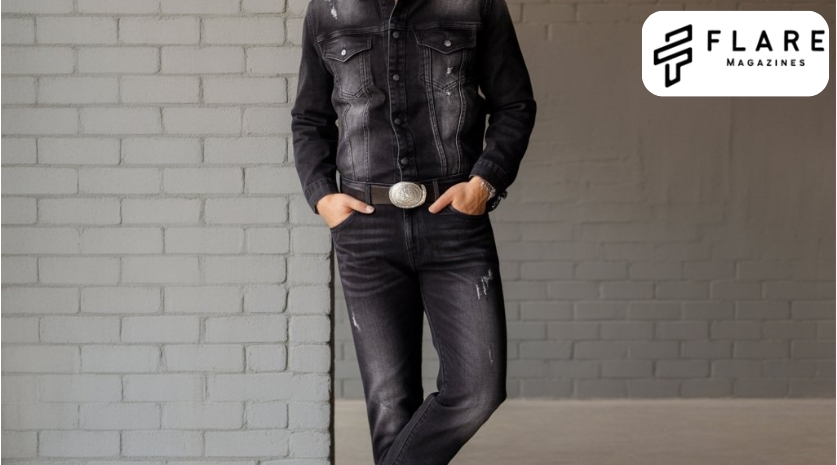
The Cultural Tapestry – Biker Jeans Beyond Function
Men’s biker jeans transcend mere clothing; they are woven into the fabric of subcultures and mainstream fashion:
- Symbol of Rebellion & Non-Conformity: Rooted in the post-war outlaw image, biker jeans men wore became synonymous with rejecting mainstream norms. While the extreme “outlaw” image has softened, the jeans retain an edge, a symbol of independence and freedom associated with the open road.
- Badge of Brotherhood: Within motorcycle clubs (MCs), specific patches worn on cuts (vests) are paramount, but the consistent uniform often includes well-worn biker jeans, signifying membership and shared identity. The jeans become part of the tribe’s visual language.
- Mainstream Adoption & Fashion Influence: The rugged style and association with rebellion made biker jeans for men attractive beyond the riding world. Designers incorporated biker details (zippers, asymmetry, heavy stitching) into mainstream fashion. The “biker chic” look, often featuring black men’s biker jeans (or fashion interpretations), became a staple. Celebrities off-duty further propelled their popularity.
- Music & Media: From rock ‘n’ roll to heavy metal, the biker aesthetic, including jeans, leather, and boots, became a powerful visual language. Movies and TV shows constantly reinforce the connection between motorcycles, rebellion, and the iconic look anchored by biker jeans men emulate.
- Heritage & Craftsmanship: The appreciation for durable, well-made goods aligns with the heritage movement. Quality motorcycle jeans for men, often using selvedge denim or premium materials, appeal to those valuing craftsmanship and longevity, mirroring the appreciation for classic motorcycles.
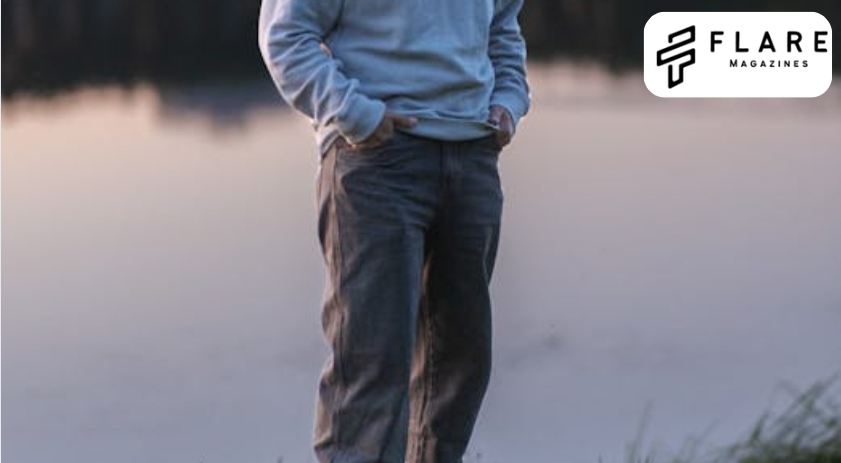
Navigating the Market – Brands, Value, and Informed Purchase
The landscape of biker jeans for men is vast. Understanding key players and value propositions is crucial:
- The Premium Protectors (Focus: Max Safety/Tech):
- Klim: Renowned for adventure and touring gear, uses high-tech materials like Kevlar® and Dyneema®, CE Level AAA offerings. Top-tier protection for men’s biker jeans.
- Rukka (L-Fashion Group): Finnish brand synonymous with premium quality, innovation (e.g., Gore-Tex laminates), and exceptional protection (often AAA). Investment-level biker jeans men trust.
- Held: German brand known for meticulous craftsmanship, premium materials (Dyneema®, Kevlar®), and sophisticated designs. High safety standards.
- Rev’it!: Dutch brand offering a wide range, strong focus on style + safety integration, innovative fabrics (e.g., Cordura® with Dynatec), extensive CE AA/AAA options. Popular choice for motorcycle jeans for men.
FAQs
1. Why are they called “biker jeans”?
Biker jeans are specifically designed for motorcycle riders. They feature reinforced materials (like Kevlar® or Cordura® in high-impact zones), abrasion-resistant stitching, and discreet pockets for armor (hips, knees). Unlike regular denim, they prioritize safety and durability while mimicking the look of everyday jeans.
2. Are biker jeans in style?
Yes, absolutely. Modern biker jeans blend functional protection with streetwear aesthetics. Key style trends include:
- Slim or tapered fits (not bulky)
- Minimalist detailing (subtle zippers, tonal stitching)
- Versatile washes (black, indigo, gray)
They’re popular with riders and non-riders alike for their edgy, utilitarian vibe.
3. Why do bikers wear skinny jeans?
Most riders avoid true “skinny” jeans for safety reasons. However, slim or straight fits are preferred because:
- They prevent fabric flapping in wind.
- They allow armor to stay positioned correctly.
- They fit comfortably under riding boots.
Note: True skinny jeans can restrict movement and compromise protection.
4. How should jeans fit men?
Ideal fit depends on style, but universal rules apply:
- Waist: Snug but not tight (no muffin top; 1 finger fits easily).
- Thighs: No excessive pulling or bagginess.
- Length: Breaks slightly at shoes (no pooling).
- Seat: Smooth, no sagging or “diaper” effect.
→ Pro Tip: Stretch denim (1-3% elastane) enhances comfort.
5. How should boyfriend jeans fit men?
Boyfriend jeans are borrowed from women’s fashion but adapted for men. They should look intentionally relaxed:

